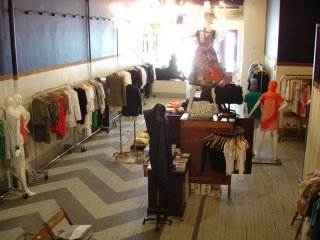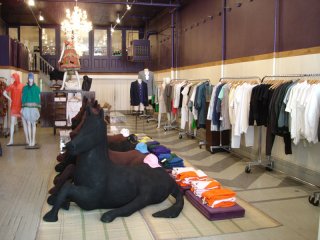Interview
Game on at Opening Ceremony
New York
It's a popularly held view that compared to other fashion capitals, New York is an unadventurous shopping town. Luxury is consumed in copious quantities, but it is luxury of mainstream design. Edgy sportswear that thrives in cities such as London and Tokyo lack an audience in the city that shops safe. There are, however a handful of new and established stores conducting a push onto consumers, challenging sensibilities and winning audience while at it — and after two years of business, Opening Ceremony can be said to fall in that category. On a recent visit, we were so struck by the unusual mix of brands (Rachel Comey, Matthew Ames, Indigo People, Mary Ping, 77 Berlin Industries, Wolfen, Tereza Santos, Frank Leder, etc) which triggered our interest to drill down and get to the core of the game at Opening Ceremony. Co-owner Humberto Leon invited Jason Campbell into his closet to discuss how the brands face off, bringing in the clients, and the strict no pretension policy.
JCR: Tell me about the premise of the store. Describe the collections.
HL: The premise of the store is that every year we focus on a different country. We select 15 designers from that country and we compete them against 15 New York designers. One of the most important part of the selection and the merchandising is to make it as unpretentious as possible. The brands do not overwhelm the space. When customers walk in they feel comfortable; whether they're trying on or looking at a $2000 dress or leaving with a $5 magazine, that's really okay.
JCR: It's about having lines that are accessible?
HL: One of the strongest things to date is that we have a very loyal customer base. My partner and I are both avid shoppers; we love shopping. There are times where you want to go and spend $600 on a pair of shoes, and there are times that you want to spend $20 on a t-shirt. And we really try to merchandise and buy for the store with that kind of mentality.
JCR: Do you buy for the customer or do you buy for you and expect them to embrace it?
HL: We buy for us. The men's collection is bought from my point of view and the women's from my partner's. The way we talk about the store, merchandise it and buy for it is like a closet. We're not saying that we own the best of the world. There's so much out there that's great just two blocks from here. What we like to sell is what we like.
JCR: How did the worldview concept come about?
HL: We opened the store just after 9/11. We were ready to leave our corporate jobs and go into this new venture, and once 9/11 happened we wanted to take the concept of the store further. We don't focus on big fashion-push countries; we're not planning to do France or Italy anytime soon. We started off with China, then Brazil, now Germany, and next year it's the UK. The UK is a good example of a country that has a lot of fashion — and fashion is a big part of the UK — but within the last four to five years last four to five years there's been a move away from London. Buyers and editors no longer go...
JCR: So it requires a new look?
HL: We took it upon ourselves to go and explore and find what is interesting in London. Saint Martins is a great school, where are those people going? What are they doing? What are some of the lines you heard about that have dropped off? For us the UK sounds very interesting.
JCR: It's not about the obvious places for seeking out talent, it's about the exploration.
HL: And we're strict about it. For instance, if there's one great designer from Paris that we love and we know would fit perfectly in our store, but we won't carry it because it won't fit into our theme. It's really important for us to be able to tell the story to our customers without confusion.
JCR: In terms of how you choose your brands, that's clear: it's regionally focused. But in terms of collective identity for the brands, can you define that?
HL: One of the things we always try to do is to represent the country away from its stereotypes. Brazil for instance, we really tried to not focus on skimpy, bikini-type clothing; it's too easy and obvious.
JCR: Instead you went for an Alexander Herchovitch, who's more artsy and intellectual.
HL: He's someone who's regarded highly in Brazil and internationally. There are some other designers who may be less regarded in Brazil that we really wanted to represent. There's this really small line, Neon that we have upstairs. If you met them you'd fall in love with them and their clothes are secondary; and then you start to fall in love with their clothes. All of that adds to how we buy.
JCR: A lot of these brands you sell exclusively in New York or in the U.S.; what does exclusivity mean at this point in time in the fashion story?
HL: I think exclusivity should come from the designer's point of view. The designer should be able to say, "I don't want my line over-distributed" because at the end of the day, you as the designer end up losing a point of view because you're in every Tom Dick and Harry store in a region. If you're in five stores in our neighborhood, as a buyer I'm probably going to look at you a little less. I won't necessarily experiment with my buy with you.
JCR: It's interesting that you address it from the designer's perspective.
HL: We never pressure designers to give us exclusives. The exclusives we have are because of the designers' choice.
JCR: Tell me about the buying process to reach the customer in an exciting way.
HL: For us, the most exciting part about Opening Ceremony is that it's not necessarily downtown and cool. That's really important to us. The customer could be the head of an architecture firm, or an 80-year-old fashionable woman, or a 15-year-old rich girl.
JCR: And do you count such a mix as your customer base?
HL: We do. We don't just target the urban point of view or the rich older lady. Again, it's like a closet. If you raid someone's closet you don't love everything but you find those one or two things that you say, "this is great; I would love to have this."
JCR: How are you able to stock so much merchandise?
HL: The store is sort of like a museum with permanent collections and visiting ones.
JCR: Tell us about the Opening Ceremony brand.
HL: We've had the brand since the beginning. We didn't want to spend our money on basics. We decided to do the basics (t-shirts, sweatshirts, etc.) ourselves and offer them at an affordable price. We were seeing so many graphic t-shirts out there, so we thought, "how can we take a look at tees and sweats differently?" So we decided not to apply any graphics and treat them as graphics themselves. Slowly the line evolved into interesting basics, and things are going very well; we're in 25 stores around the country.
JCR: The wholesale part of the business is key to the business plan?
HL: Yes. We also have a showroom representing 10 of the designers that we carry in the store. It was very natural to open a showroom. A lot of buyers were interested in carrying some of these lines and some of them are only carried in our store and the only way to reach them was in another country. Language, etc. was an issue. So we thought about how we could help some of these designers. Also, at the end of the year if we don't carry a designer any longer, how can we continue to work with them and help them expand?
JCR: How do trends figure into this program?
HL: The trend part is very difficult. My partner and I make very specific buys; again, specific to us. If there was a straw trend, for example, but we didn't believe in it, we wouldn't buy it. We buy into it because we like it.
JCR: But you do have an eye on trends in terms of sensibilities on the rise?
HL: Trends are not an obsolete issue. It depends on which designers we carry. We work with the designers first, then we look at their collection. If the designer were pretentious or had a point of view that we didn't believe in, we wouldn't carry them, whether or not the collection was fantastic.
JCR: What about the concept of buying into brand name? Is that a relevant discussion for Opening Ceremony?
HL: The interesting thing about going to these countries is looking for the non-brand names. And we always want to represent the heritage of the country; so along with that usually comes a name or two that are a bit more established. We try to carry one or two established designers to round out the story, the young designers, and other parts of the country whether from flea markets that we find, we carry that as well. Compared to everything else, the brand-name designer factor is really played down.
JCR: Tell me about the climate for this kind of clothes in New York at the moment.
HL: Most of the customers who come here come back because they know that we offer things that other people might not. I think partly it has to do with many of the designers here are young designers who are a lot less inhibited to do random quirky things that may not be that understandable by the average consumer. If you look, we have Bless, which I think may be an un-consumer-friendly label; yet there is a following for it. And there's that customer who likes that kind of fit. The way the store is going and the fact we have these many lines and are able to support it, it's very exciting to see that there are consumers who want to go this route.
Photos: Opening Ceremony interior
JC Report














